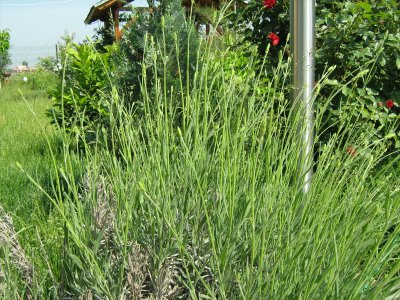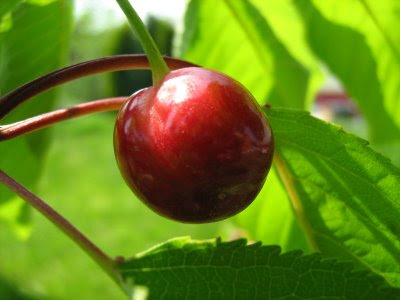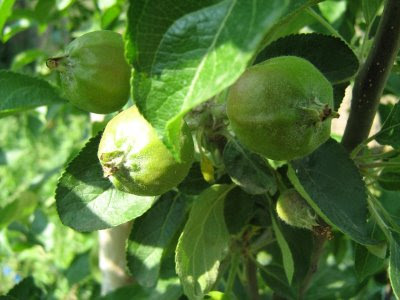Pe aceasta adresa de e-mail va astept intrebarile, propunerile, sugestiile sau sfaturile!
Use this e-mail address for any questions, proposals or advices you might have!
sâmbătă, 30 mai 2009
Primrose - Primula
As you all know, Primrose is a spring flower, so it is in vain to take a picture now, because mine has no flowers. You can find a lot of colours of Primula, mine is mauve. She loves bright places, but no direct sunlight, and in blooming time is better to wet it a lot. Be careful when you wet it not to touch the flowers with water. It's better to wet it under the leaves.
Interesting facts
Daca mancati o Primula, puteti vedea zane! Va tenteaza? :)
Prietenii din Austria au o Primula alpina pe moneda de 5 Eurocenti.
Exista aproximativ 400 specii de Primula.
Femeile ar trebui sa foloseasca ulei de Primula, pentru ca ajuta aparatul genital feminin si regleaza nivelul de hormoni din corp. Mai mult decat atat, stimuleaza arderea grasimilor si imbunatateste calitatea pielii si a unghiilor, datorita continutului de acizi grasi.
Ciubotica-cucului popular sau Primula auricula este planta alpina si este protejata de lege.
If you eat a Primula you can see fairies! Are you tempted? :)
Our friends from Austria have an alpine Primula on the 5 Eurocents coin.
There are aprox. 400 species of Primula.
Primula oil helps women to regulate hormon's level and protects genital organs. More of that, stimulates fat burning and improves the nails and skin quality because contains fat acids.
Ciubotica-cucului (mot-a-mot translation "Cuckoo's boot") is the popular name for Primula auricula. It is an alpine plant and it is protected by law.
miercuri, 27 mai 2009
Kalanchoe


Aceste 2 Kalanchoe, alba si roz, le-am cumparat acum cateva saptamani din Hornbach. Imi plac Kalanchoe-le, mai am una rosie, iar anul trecut am avut alte trei, care, din pacate, nu au rezistat peste iarna.
I bought these two Kalanchoe, white and pink, a few weeks ago from Hornbach. I like Kalanchoes, I have another one red, and last year I had three who died.
Sunt flori suculente, carora le place lumina, chiar soarele direct, nu au nevoie de multa apa sau de spatiu. Nu cresc mult in inaltime, daca aveti noroc ajung pe la 20-25 cm. fara flori si pe la 30 cm. cu tot cu flori.
These are juicy flowers, likes the light, even direct sun, don't need too much water or space. There are not so tall, with luck can reach 20-25 cm. without flowers and 30 cm. with flowers.
Provine de pe continentul african si din Madagascar. In Europa e des intalnita, mai rar se gaseste in America sau Asia.
It came from Africa and Madagascar. In Europe is a common flower, in America and Asia is not so common.
Daca veti citi pe anumite site-uri despre Kalanchoe, inclusiv pe blog-uri, veti afla ca acestei plante ii place solitudinea. Normal, din moment ce toti copiaza unul de la altul!!! Nu, nu este neaparat adevarat. Evident, sunt foarte multe plante carora le place sa fie singure in ghiveci, dar asta nu este o regula. Daca vreti sa faceti un mix de flori, Kalanchoe este ideala pentru acest lucru. Dar trebuie sa tineti cont sa o "asociati" cu alte plante suculente, ca sa fiti siguri ca nu omorati vreuna dintre ele. O alegere foarte buna este Crassula, mai ales ca fac parte din aceeasi familie, Crassulaceae. Am avut si Crassula, dar pe vremea aceea nu stiam atat de multe despre plante si am omorat-o, punandu-i multa apa.
If you will read on some sites about Kalanchoe, including blogs, you will find out that this flower loves solitude. Of course, since they are copy-pasting from one to another!!!! No, it's not necessarily true. Of course, there are a lot of plants who loves to be alone in the pot, but this is not a rule. If you want to make a mix pot, Kalanchoe is an ideal plant to do this. But you have to "associate" it with other juicy plants, to be certain that you will not kill them. A very good choice is Crassula, especially they are part of the same family, Crassulaceae. I had a Crassula also, but back then I didn't know so much about plants and I killed it with too much water.
O alta informatie preluata gresit pe site-uri: veti afla ca sunt 130 specii de Kalanchoe. Si 180 specii. Chiar si 200!!! In realitate, exista aproximativ 120 specii de Kalanchoe, cele din Madagascar pot ajunge si pana la 6 metri inaltime. In 1763, botanistul francez Michel Adanson a descris pentru prima oara aceasta floare. El a stat in Senegal timp de 5 ani si cand s-a intors la Paris, dupa numeroase cercetari si descoperiri in Africa, a publicat cartea "Familles naturelles des plantes", in care a descris cele 58 familii de plante pe care le-a diferentiat, precum si multe alte informatii.
Another wrong information: on some sites you will find out that there are 130 Kalanchoe species. And 180 species. Even 200 species!! In reality, there are aprox. 120 species, the ones in Madagascar can reach 6 m. height. In 1763, french botanist MIchel Adanson described for the first time this flower. He was in Senegal for 5 years and after his return in Paris he published the book "Familles naturelles des plantes". He conducted a lot of researches and made a lot of discoveries and he described 58 families of plants and other useful information.
Ziceam ca mie mi-au murit 3. Mda... pentru ca pot fi atacate foarte usor de cosenile si purici. Am luat un spray anti-cosenile, dar prea tarziu, se pare. Mare atentie, exista spray-uri chimice si altele pe baza de plante. Va sfatuiesc sa le alegeti pe cele naturale, in primul rand pentru planta. Dar nu ar strica sa va paziti si voi sau animalele de casa!
I told you that I lost three Kalanachoe. Yeah... because they were atacked by fleas and other bugs. I bought a spray but too late. Be careful, there are chimical based sprays and plant based. I advise you to chose the natural ones, to protect the plant. But it's good also for the pets!
luni, 25 mai 2009
My garden at the beginning of June - Gradina mea, la inceput de iunie

Pui de porumbel - Pigeant cubs

Levantica - Lavender

Crin salbatic - Wild lily

Prima capsuna pe 2009 (Mount Everest) - First 2009 strawberry (Mount Everest)

Noua noastra piscina, cadou de la finii nostri - Our new outodoor pool, a present from our godsons

Trandafirul rosu de langa foisor - The red rose close to the garden wooden tower

Trandafirul alb si zeci de boboci - The white rose and dozen of buds

O parte din gradina si iarba proaspat taiata - A part of the garden and the newly cut grass

Rasadurile de rosii din spatele casei - Tomatos seedlings in the back of the house

Margarete - Ox-eye daisy

Una dintre ciresele de anul acesta - One of this year's cherry

3 mini-mere - 3 mini-apples

O floare de trandafir alb - A white rose flower

O floare de trandafir rosu si 5 boboci - A red rose flower and 5 buds

sâmbătă, 23 mai 2009
Update Lavender - Levantica
If I talked about the savory, I would like to talk about lavender as well. I bought 2 years ago a small lavender, about 10 cm height. Right now looks like this:
Levantica este o planta din aceeasi familie ca si menta si poate ajunge pana la 1 metru inaltime, mai ales datorita florilor inalte. Infloreste prin iulie, uneori august, daca e mai putin cald in iunie sau iulie. Cea mai comuna culoare a florilor este albastru, dar pot exista si alte varietati - mov sau fucsia. Dupa cum puteti observa in poza de mai sus, exista frunze argintii, cele vechi si frunze verzi, cele noi, de anul acesta.
The lavender is a plant from the same family as the mint and can reach 1 m. height, especially because of the tall flowers. Blooms in july, sometimes august, if it's less warm in june or july. The most common flowers' colour is blue, but you can see in purple or fucsia. As you can see in the above picture, there are some silver leaves, the old ones, and green leaves, newer ones.
Se pot folosi si frunzele si florile, primele fiind mai amarui, cu un gust mai puternic. Ca si cimbrul, levantica provine din spatiul mediteranean si se foloseste la salate in amestecuri de ierburi aromatice. Din frunze si flori se fac uleiuri si oteturi. Dupa cum ii spune si numele, se folosea cu precadere la uleiurile pentru baie. Provine din latinescul "lavare", care inseamna a spala.
You can use either leaves or flowers, first ones being a little bit bitter, powerfull taste. Like the savory, the lavender came from mediteranean space and is used in salads, in a mix of aromatic herbs. From flowers and leaves can be made oils and vinegars. As the name said, the lavender was used primarily as bath oil. Came form the latin name "lavare", which means to wash.
In bucataria franceza din regiunea Provence, levantica se foloseste la mancarurile de peste, porc, vita, pui sau in preparate de legume pe baza de vinete, rosii, ardei. Oricum, trebuie folosita cu mare atentie, pentru ca aroma amaruie si mirosul puternic se "extind" in mancare si veti avea mancare de levantica, in loc de dovlecei, de exemplu. Daca vreti neaparat sa o folositi la ceva, va recomand inghetata de levantica. Sau piept de pui cu levantica si miere. Aaa, cum suna?
In french cuisine from Provence region, the lavender is used in fish dishes, pork, beast, chicken or in vegetables dishes with egg-plant, tomatoes, pepper. Anyway, you have to use it carefully because the bitter taste and powerfull smell are conquering the food. If you want to use it, I recommend you lavender ice-cream. Or chicken breast with lavender and honey. A, how does it sound?
Tot Franta este producatorul numarul 1 in lume al uleiului de levantica. Lor le place foarte mult aceasta planta si o folosesc foarte in zona alpina.
France is the number 1 in the world on producing lavender oil. The french people love this plant and use it in the mountain area.
Bunicii nostri o foloseau ca tratament eficace impotriva muscaturilor de insecte, in sifoniere impotriva moliilor (toata lumea isi aduce aminte de mirosul pernelor sau prosoapelor impregnate de levantica), pentru a desfunda nasul, iar noi o folosim ca ulei aromatizant - ne ajuta sa avem un somn linistit sau in apa de baie, pentru a ne relaxa si linisti.
Our grandfathers use it as medicine against insects bites, against moths, in dressings, against colds, and nowdays we use it as aromatic oil - helps us to have a peacefull sleepor in bath tub, to relax us.
Trandafirul meu alb a fost atacat de paduchi. O varianta excelenta de a scapa de ei este sa plantez o tufa de cimbru sau de levantica in imediata apropiere.
My white rose is full of lices. An excelent way to kill them is to plant a bush of savory or lavender near it.
Mai am 2 close-up-uri cu tufa de levantica, iar saptamana viitoare cred ca se deschid si florile. Da, stiu ca am spus ca infloreste in iulie-august, dar tinand cont ca ieri au fost 31 grade, iar astazi se asteapta 33 grade Celsius, este firesc sa infloreasca la inceputul lui iunie anul acesta.
I have another 2 close-ups with the lavender bush, and next week I think the flowers will bloom. Yes, I know I said it blooms in july-august, but taking into consideration that yesterday were 31 C degrees, and today we are expecting 33 C degrees, it is normal to bloom at the beginning of june this year.


joi, 21 mai 2009
Savory - Cimbrul
I know you missed me and I know that I didn't wrote a post for sometime. That's because I was exclusively involved in Bride Parade project, physically and emotionally.
Revin in forta si vreau sa va vorbesc despre cimbru. Am primit acum vreo 3 saptamani un cimbru salbatic, aduc tocmai din Grecia, dintr-o insula. Din pacate, la momentul la care scriu acest post, cred ca nu il mai pot resuscita. Dani il uda constant, dar ramurelele verzi pe care le puteti observa in fotografii nu mai sunt de mult timp verzi.
I am back and I want to talk about savory. 3 weeks ago I received a wild savory, brought all away from Greece, from an island. Unfortunately, as I write this post, I think I can not bring it to life. Dani wet it constantly, but the green leaves as seen in the pictures are no longer green.
Imi pare rau, pentru ca cimbrul este o planta extraordinara. Evident, venita din tarile mediteraneene, ca Grecia, Italia. Ii place mult soarele si adora stancile si formatiunile stancoase. Al meu a fost smuls de pe o piatra si puteti vedea in fotografii, are o forma ciudata, sa se apere de vant si ploaie.
I am sorry because the savory is an extraordinary plant. Of course, from mediteranean countries, like Greece or Italy. Loves the sun and the rocks. Mine was taken from a rock and, you can see in the pictures, has a funny and odd shape, to protect itself from rain and wind.
Este o planta aromatica, cu un miros aparte si are efecte curative si terapeutice. In Romania a ajuns pe undeva prin secolul 11 si a fost foarte apreciat. Specia comuna atinge cam 50 cm inaltime, celelalte ating maxim 30 cm. Seamana cu rozmarinul si levantica, dar nu le poti confunda datorita mirosului.
It is an aromatic plant, with a particular smell and has therapeutical effects. Around 11 century came to Romania and it was well appreciated. The common species can reach 50 cm height, the other reach maximum 30 cm. It looks like lavender and rosemary, but you can not mixed them up because of the smell.
Femeile care au copii, cred ca stiu ca bunicile le recomandau ceai de cimbru, pentru a naste mai repede.
Women with children know that the grandmothers recommend savory tea for earlier and faster birth.
Pe vremuri, in Evul Mediu, se numea lamaita si se folosea foarte des in manastiri. Chiar si acum, in zilele noastre, culturi importante de cimbru se pot gasi la manastirile din Moldova. In Europa, doar Romania si Elvetia cultiva aceasta planta. In restul tarilor, de la Portugalia pana in Grecia, el creste spontan.
In Middle Ages, the name was aloysia and it was used in monasteries. Even nowdays, Moldavian monasteries have large crops of savory. In Europe, only Romania and Switzerland have savory crops. The other countries, like Portugal or Greece, have spontaneous crops.
Cimbrul nu este recomandat in perioadele caniculare, pentru ca accentueaza starea de caldura insuportabila.
The savory it is not recommend it in canicular times, because emphasises the unbearable heat.
Numele din engleza a fost influentat de un alt cuvant din engleza, savoury, care inseamna picant. Cimbrul poate fi folosit cu succes ca inlocuitor de piper, pentru cei cu intoleranta la acest condiment.
The name in English was influenced by an English adjective, savoury. The savory can be used succesfully as piper substitute, for those with intolerance to piper.
Se foloseste in special la preparatele din legume, ciorbe, salate sau chiar ciuperci, pentru ca ajuta foarte mult digestia. In mod normal, el trebuie adaugat chiar la inceputul prepararii legumelor, pentru ca prin procesare indelungata, isi pierde din proprietati.
It is used especially in vegetables meals, sour soups, salads or even mushrooms, because helps the digestion. Normally, you have to add it at the beginning of the cooking, because through a long processing looses the qualities.
Nu am cunostinte despre utilizarea cimbrului in SUA, dar poate ne ajuta prietenele mele de peste ocean.
I don't have any information about the savory usage in USA, but maybe my friends from the other part of the ocean can help me.
Am si 3 fotografii, cu el inca verde.
I have 3 pictures, when it was green.



miercuri, 6 mai 2009
Vita-de-vie
First of all, you can find the grape vine in numerous places, from Iran to Maroc, from Germany to France, from Asia to Romania.
Nu stiu daca stiati, dar vita-de-vie este, de fapt, o liana, ce poate atinge chiar si inaltimea de 35 metri. Exista si varianta salbatica, cu fructe mici, de 5-6 mm.
I dont't know if you know that, but the grape vine is in fact a liana with a maximum height of 35 m. It has also a wild species, with small fruits, 5-6 mm.
In America de nord a ajuns in jurul anului 1600, cand noi eram cu Mihai Viteazu si a sa unire. Ceea ce exista in Europa si pe alte continente in momentul de fata ca vita-de-vie provine dintr-un soi altoit din America de nord, ca sa poata face fata Phylloxerei. Vreo cativa ani, Europa a ramas fara productie de vin datorita acestei insecte.
In north America the grape vine is reported around 1600, when we were with Mihai Viteazu and its Unification. What exists in Europe and other continents right now results from a graft species from north America, to survive over the Phylloxera. A few years, Europe left without wine production because of this insect.
In Georgia s-a descoperit un depozit de vin vechi de 7.000 ani, asa ca eu zic ca toata lumea aprecia aceasta bautura, inca de cand a aparut femeia, hehe.
In Georgia, a wine cellar was discovered 13 years ago, 7.000 years old, so I think everybody loved this drink, ever since the woman was made up, hehe.
Normal, chinezii, grecii si egiptenii nu s-au lasat mai prejos si au folosit strugurii pentru a prepara vin, dar si pentru a vindeca anumite boli de piele sau ochi. Deoarece contin vitaminele A si B, precum si un colorant cu rol tonic (cei negri), se recomanda chiar si cure de struguri, de 1-2 kg pe zi, pentru a preveni sau trata anumite afectiuni.
Of course, chinese, greeks and egyptians used the grapes to make wine, but also to cure some skin and eyes diseases. Because the grapes are full of A and B vitamins and tonic dye (black ones), it is good to have a grapes diet, 1-2 kg per day, to prevent or to cure some diseases.
La facultate am invatat ca in simbolistica traditionala, vita-de-vie reprezinta trupul lui Isus, iar vinul sangele Lui. Burebista a vrut chiar sa distruga toate culturile de vita-de-vie, pentru ca credea ca oamenii lui sunt tulburati datorita vinului baut.
In college I learned that in traditional symbolistic, the grape vine represents Jesus body, and the wine Its blood. Burebista wanted to destroy all the grape vines because he thought that its people are troubled by the wine.
La Simleul Silvaniei a fost gasit un colier dublu de aur, datand din veacurile III-IV, avand insirate mai multe reproduceri in miniatura ale unor unelte, printre care si un cosor de vie si o foarfeca de vie; el este impodobit cu cinci foi de vita stilizate.
In Simleul Silvaniei was found a double golden necklace, from 3-4 century, with mini-reproduction of tools, a grape vine and a scisor. It has also 5 grape leaves.
La traci, greci si romani, zeul fructelor, vegetatiei si mai ales al vitei-de-vie si al vinului, era Dionysos, caruia romanii ii spuneau Bacchus.
Tracs and greeks had Dionysos, romans had Bacchus - the fruits, vegetation and grape vine god.
Noi avem 5 butasi de vita-de-vie plantati langa gard, dar e de-abia al doilea an, asa ca nu ma astept sa avem struguri mai devreme de 2010, chiar 2011.
We have 5 grape vine planted near the fence, but it's only the second year, so I'm not expecting any grapes before 2010 or even 2011.
Nu am vrut sa va plictisesc cu lucruri deja stiute despre vita-de-vie, m-am gandit sa vin cu cateva informatii interesante si prea putin stiute. Fotografii nu am, pentru ca butasii nostri au cam 10 cm inaltime, dar sper ca stiti cum arata, hehe!
I didn't want to bore you with information that you all know about the grape vine, I thought I will come with some interesting stuff. I don't have pictures, because our grape vines have only 10 cm height, but I am hoping that you all know how it looks, hehe!
Rome, Italy - Roma, Italia
We were in a mini-vacation, so waited and needed, to Rome, Italy. I know I promised that I will talk about grape vine, but, to soften you, I will show you some pictures from Rome.
Maine va astept din nou pe site! Adica ma intorc la treaba si vin cu informatii noi!
Tomorrow I am expecting you again on my site! That means I am back in business and I will come with new information!

Triumph arch next to the Colosseum





















